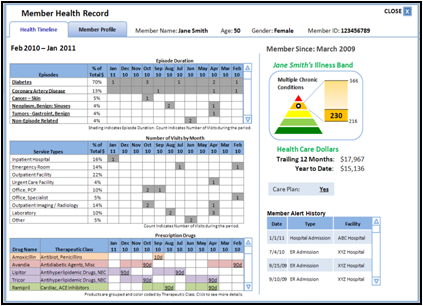Entries in online health and wellness coaching (15)
Shared Decision Making Tools Engage Consumers for Better Outcomes and a Better Experience
 September 27, 2011
September 27, 2011  CareFirst BCBS Medical Home SDM Tool
CareFirst BCBS Medical Home SDM Tool
Over two years ago, I led a panel on patient decision support tools for a large interested crowd in Boston, despite the very snowy day.
Since then, I have noticed a few key changes. Physicians are now prescribing information to patients, using the EMR to send emails with links to health resources. And innovative health plans are playing a role in bringing shared decision making tools to engage and empower their members. Health Plans have a big cost saving incentive when these tools educate their members about less invasive and less expensive options.
3 Key Engagement Drivers With Shared Decision Making Tools
While evaluating technologies for my panel on “Evolving Web & Mobile Tools to Engage Consumers in the Shared Decision Process”, I identified how three key drivers of consumer engagement are being utilized:
1. Education
These tools show the consumer what the treatment entails and share patient stories which tell them what to expect. This education reduces anxiety by putting the consumer in control to understand their health issues and presenting options to address them.
2. Evaluation
Shared Decision Making tools are ideally designed for “preference sensitive conditions” where there are multiple clinical options (For information about target conditions, see the recent report on the Dartmouth Atlas Project which was developed with The Foundation for Informed Medical Decision Making). The most effective tools offer alternatives, capture preferences and guide the consumer through the process while documenting their decisions. This helps set expectations for their experience and supports the discussion with their doctor or care coach.
3. Collaboration
As the patient and clinician/coach review the SDM summary document together, they can discuss questions, concerns and comments to make the best decision.
Health Plans Leverage Shared Decision Tools
During the panel, health plans described using Shared Decision Making tools to engage members in two key areas:
- Medical Home
Panelist Zev Lavon, PHD, Director Solution Architecture, CareFirst BCBS emphasized “the story of the patient is not their last doc visit or lab test”. CareFirst launched their Primary Care Medical Home initiative across a panel of physicians deploying communication tools to push information to patients to support the management of their chronic conditions.
-
Wellness Coaching
According to Mark L. Robitaille, MBA, Head of Care Management Support & Engagement, Aetna puts these tools into the hands of their health coaches to send emails with resources links to members or use the tools to look up information for the members without internet access.
Independent Health panelist, James J. Mis, MBA, Communications Manager, Health Care Services, described their interactive voice response campaign to inform members about viewing a shared decision making video (from Emmi Solutions) selected for their specific health interest.
Emerging Mobile SDM Tools
With a high penetration of smart phones and strong usage across minorities, health care organizations are realizing the tremendous opportunity to deploy mobile applications to engage consumers. To date, most health mobile health applications have been focused on wellness with educational information and tracking.
Panelist Changrong Ji, Senior Solutions Architect, CareFirst BCBS described the opportunity for mobile shared decision making tools. In the future, she envisions that sensors will capture the context of the consumer’s daily life, database analytics will identify patterns and machine learning will be used to help identify relevant mobile messages to send back to the consumer.
Healthwise’s View on Patient Response
During the Shared Decision Making Summit, the chairperson, Don Kemper, Healthwise’s CEO discussed the opportunity for shared decision making tools to give a “voice to the patient”. After the physician prescribes health information, the tool gathers patient’s preferences to document them in the medical record. I strongly agree with Don as he explains “there is no better way to engage the patient than to assure them that their voice will be heard in treatment and care plan decisions”.
Shared Decision Making Tools for Your Consumers
What are you doing to bring Shared Decision Making Tools to your consumers to motivate engagement in their health and wellness? I can help guide you through the process of identifing, evaluating and piloting these technologies to deliver better outcomes and a better experience for your consumers.
Evolving Web Based and Mobile Tools to Engage Consumers in the Shared Decision Making Process
 September 6, 2011
September 6, 2011

World Congress Leadership Summit on Shared Decision Making
September 23, 2011
Panel Session:
Moderator:
Sherri Dorfman, MBA, Chief Executive Officer, Stepping Stone Partners
Panelists:
- Mark L. Robitaille, MBA, Head of Care Management Support & Engagement, Aetna
- Changrong Ji, Senior Solutions Architect, CareFirst BCBS (Mobile strategy)
- Zev Lavon, PHD, Director Solution Architecture, CareFirst BCBS (Web strategy)
- James J. Mis, MBA, Communications Manager, Health Care Services, Independent Health
 care collaboration,
care collaboration,  mobile health and wellness texting,
mobile health and wellness texting,  online health and wellness coaching,
online health and wellness coaching,  patient centered medical home,
patient centered medical home,  personalization for health and wellness in
personalization for health and wellness in  Decision Support eHealth,
Decision Support eHealth,  Mobile Engagement Health & Wellness,
Mobile Engagement Health & Wellness,  Patient Decision Support,
Patient Decision Support,  Personalization eHealth,
Personalization eHealth,  shared decision making ehealth
shared decision making ehealth New Directions in Employee Engagement: Competition, Coaching, Community & Compensation
 June 2, 2011
June 2, 2011 Our Panel at the 8th Annual Healthcare Unbound Conference 2011
 According to a recent Towers Watson survey, fewer employees have taken "action to improve their health” in 2010 than in 2008 (59% compared to 65%) which is a surprise given the rise in chronic conditions. Further findings are that “27% would not participate in wellness efforts without incentives”.
According to a recent Towers Watson survey, fewer employees have taken "action to improve their health” in 2010 than in 2008 (59% compared to 65%) which is a surprise given the rise in chronic conditions. Further findings are that “27% would not participate in wellness efforts without incentives”.
What are employers and health plans doing to successfully motivate consumers to participate in their wellness initiatives?
During this panel on employee engagement, you will learn:
· How virtual coaches are getting personal and gaining results
· Ways social graphs are being used to map and leverage influencers
· How reward strategies and behavioral economics are being utilized to produce behavior change
Moderator: Sherri Dorfman, MBA, CEO & Consumer eHealth Specialist, Stepping Stone Partners
Panelists:
- Bryce Williams, Director, Wellvolution, Blue Shield of California
- Pat Sukhum, Co-Founder & Director of Marketing, RedBrick Health
- Lisa McGill, VP, Worldwide Human Resources, Brocade Communications Systems (Self Insured Employer)
Patients in Control Demonstrated in MIT's New Media Medicine Group
 May 11, 2010
May 11, 2010  Recently, I sat down with Dr. John Moore, Researcher in the New Media Medicine Group of the MIT Media Lab.
Recently, I sat down with Dr. John Moore, Researcher in the New Media Medicine Group of the MIT Media Lab.
“With our CollaboRhythm, we are redefining the relationship between the patient and their doctor”, explained John. “Instead of being in control, the doctor is serving as a coach to help the patient with their care planning and delivery.”
As I watched the demo, what surprised me the most was that the patient was interacting with the flat screen displaying her information and deciding about her upcoming treatment. John described what was happening. “This is ‘shared decision making’ in action where the patient determines what changes she wants to make and even schedules her medication while the doctor is by her side providing guidance as needed.”
When the patient leaves her doctor’s office, she is ready to follow through on the plans she made. “All of the follow- up information has been pushed to the electronic devices that she will rely on. Her pill dispenser has been automatically programmed. Her mobile phone is ready to receive the reminders and the necessary sensors are in place to track her activities”, John mentions with a smile.
Next, I saw a demo of the “I’m Listening” project, designed to bring the patient into her own care management process. The patient is relaxing on a coach in her living room with a cup of coffee as she is having a conversation with an “avatar” on her flat screen television. “The avatar agent asks the patient questions to gather information for her clinician. This gives the patient more freedom to share her story at her own pace”, explains John. When the patient wants to show the sore on her foot to her doctor, she lifts her foot in front of the build- in camera to have a picture taken.
I was interested to learn that this system takes all of the information gathered including the ‘words of the patient’ as well as photos and organizes it for her next doctor's appointment which she schedules. Notice the time savings for the doctor and the convenience for the patient.
With both projects, the patient has a more proactive role in managing their own health, the doctor remains in an “expert” role and their collaboration and communication are enabled through technology.
What About You?
- What are you doing to empower consumers?
- How are you engaging consumers to share their health data with you?
- Are you gathering and organizing the consumers' health information to support care decisions?
Although MIT's patient- focused products were developed in the lab, there is so much we can learn from their approach. They put the patient in control of their health with access to information and collaboration with their clinician for guidance. Technology plays an important role of seamlessly moving the patient's information to where it is needed (e.g. devices) for further interaction. During these interactions, technology enables the collection of patient data to support shared health decisions.
Series: Engagement Path #3- Motivate & Guide Me
 April 7, 2010
April 7, 2010  Healthcare organizations are realizing they can leverage technology to help personalize the experience with needed motivation and guidance. Consumers benefit from expert information and tools tailored to their individual goals and interests. These personalized resources not only motivate but also guide the consumer through their “decisions of daily living”. They need guidance when determining how to eat more healthy, improve their fitness as well as manage their stress.
Healthcare organizations are realizing they can leverage technology to help personalize the experience with needed motivation and guidance. Consumers benefit from expert information and tools tailored to their individual goals and interests. These personalized resources not only motivate but also guide the consumer through their “decisions of daily living”. They need guidance when determining how to eat more healthy, improve their fitness as well as manage their stress.
“Help me set realistic fitness goals and give me ongoing feedback on my progress.”
“Just tell me what to do to lose the weight.”
“Keep reminding me about ways to lower my cholesterol.”
“Help me find way to improve my sleep.”
“Motivate & Guide Me” Opportunity: Gain commitment, proactively push to reach goals, deliver actionable information, provide decision support tools and share ongoing feedback.
Engagement in Action:
- Wellcoaches offers a high touch service enabled by technology which puts the consumer in control of their plan and progress towards goals. The Wellcoach continues to hold their client “accountable” for making needed changes to reach these goals. Armed with insight about the consumer’s preferences for exercise and diet, the coach constantly pushes for progress incorporating these preferences into the plan. In addition, the Wellcoach serves as a cheerleader celebrating accomplishments along the way.
- Sensei leverages technology to deliver a personalized experience for weight loss. The “virtual dietician” recommends meals based on the consumer’s stated food preferences and lifestyle. Sensei pushes out the fitness message as a reminder for today’s activity plan “motivational messages” showing progress toward the goal and “behavior” messages to focus the consumer on healthy alternatives. MySensei provides access to tools including a shopping list to motivate healthier food choices.
Motivation is individual and varies based on the consumer’s unique set of health issues and readiness for change at that time. Even consumers who are self-motivated need information and tools to guide them and help them confidently navigate the decisions when coming to a fork in the road.
Most consumers need a more comprehensive solution which responds to triggers for need, delivers personalized information and tracks effectiveness to inform future touches.


